MusicMaster Blog
Take Shortcuts! posted on November 29th, 2023
by Chris Hulsether
If you like to use your keyboard to hit a button or two and get where you want to go, you’re in luck! MusicMaster has all sorts of ways to help you whip through your database quickly and efficiently using your keyboard.
In this article, I will go over the many ways to use keyboard shortcuts. We have basic default keyboard shortcuts that can be used in your Library Maintenance, Schedule Editor, and more. Also, I’ll show you how to turn on and use our Hotkey Emulator, which will bring shortcuts you may have used before with other music scheduling systems. We also have a way to add your own customized hotkeys.
MusicMaster Shortcuts
For reference, you can print off the list of all the shortcuts we have in the software. Go to Help/Index and search “Shortcuts”.


Then click Print and print to paper or PDF and save it where you want.

Here are some helpful shortcuts you can use in Library Maintenance:
For example, you can hit F6 to view your History Graph and review how a song has scheduled throughout the weeks. When you need more room to review other songs in your library, hit F6 again and the graph closes.
F7 allows you to Mark a song. Typically, it’s marked in powder blue. You can mark songs for reference or use this to perform batch operations on all marked songs. If you right-click on your library grid to open the context menu, you’ll see options available for marked songs, such as Move, Copy, Delete, Merge, and Print.

Hit ALT+ F7 and the marking song utilities will open.

If you have a bunch of marked songs, SHIFT+F7 will jump to the next marked song.
You can also open the library query window with CTRL+Q to search your library for specific things. Whatever field you are in when you hit CTRL+Q will become the search filter. For example, if you are in your Artist Keyword column and hit CTRL+Q on a song, the query window will already be set to search Artist Keywords.

Heading over to the Rule Tree, you can use CTRL+W to open the Rule Tree Wizard and see recommendations for changes. (Learn about the Rule Tree Wizard here).

In the Schedule Editor, you can use F5 on two songs to swap them. Select the first song you want to move, hit F5, and you will see a red mark on the left side. Then select the other song you want to swap with and hit F5 again. The two songs will swap positions.

If you want to have more space to see your log and you have the History Graph and InfoBar open, you can toggle them on and off with F6 for the History Graph and F11 for the InfoBar.


If you have rule failures or unscheduled positions as a result, you can use shortcuts to jump to each so you can replace the song. Hit CTRL+N to go to the next rule failure and Ctrl+P to go back to the previous rule failure.
HotKey Emulator
How about those Hotkeys you used to use in other software and still have the muscle memory for?
Go to Tools/Options/Additional Options:

Change Hotkey Emulation to a 1 and these shortcuts will be turned on.
These hot keys will work on any non-editable field in the Editor. It changes nothing when you are in an editable field like Artist or Title. These functions are available:
1 – Search for songs where the Auto Match field matches the current song
2 – Search for songs where the Auto Match field matches the previous song
4 – Open the Vicinity Viewer
A – This requires the Additional Properties, AutoMatchField to be set to the Field ID of the keyword you wish to use. With the history graph then open, pressing “A” will change the graph to show the keyword display.
G – Select a song from a saved song list, where it first opens a box allowing you to select a saved list.
J – Swap songs
K – Load songs from the category of the current song into the replacement song window
O – Undo
Q – The Q Filter pops up a list of song attribute codes to search for
S – Schedule from selected category where a pop up lists the categories and the songs from that category
U – Unschedule the active element
X – Toggle the Element Mask to show/hide music and non-music elements
Y – Opens the Yesterday Window (the MusicMaster Schedule Review showing the log from the previous day)
Custom Key Mapping
This is where you can add some customization to your Shortcuts. It’s available both in the Library and Schedule Editor.
Let’s look at how to set this up in Library. Open your Library Maintenance, then go to the menu bar and click on Library > Key Mapping.

Now, you can add shortcut keystrokes to use while you go through your library.
Select the key you want. I selected ALT+1 for layout editor. This allows me to pull up the grid layout editor and add/remove things from my library grid. You can set one for saving your changes or loading a different layout.

You can do the same to bring up things like the Attribute editor, Keyword editor, the Mass Changer and many other tools.
In the Schedule Editor, you can do the same. Shortcut options include various audio playback controls, replacement song functions, history snapshots, publishing to automation, navigating within your logs, toggling between layouts, and so much more!

Today more than ever, you need ways to take a shortcut and get more out of your database in less time. Contact your Music Scheduling Consultant for assistance.
Clicking (the “Right” Way) posted on June 28th, 2023
By Dave Tyler
MusicMaster is a powerful and robust software, we all know that! But did you know there are many different ways of using it? I am always looking for ways to accomplish something in fewer clicks. Before you call me lazy, let me redirect by saying I am an efficiency junkie. I have been involved in the martial arts for 40 years and efficiency is paramount in successful technique. To bring this back around to music, Elvis really was a Black Belt and studied with an incredible American Kenpo master named Ed Parker who frequently used the term “Economy of Motion” to describe the process of optimal form to gain speed and power. This Economy of Motion is built into MusicMaster too!
I have said many times there are many ways to just about everything in MusicMaster, and for me at least, the “Right Click” is my secret weapon to quickly getting where I want to be in the software. Let’s take a look at what I mean.
The Info Bar
This is the place where all of our categories live and are arranged. Did you know you can right click here to pull up a variety of destinations?
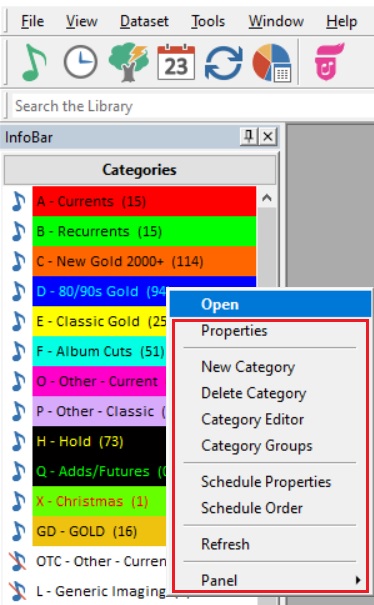
This box allows you to do multiple things like see the properties of the category you clicked on or create a new category, delete a category, open the Category Editor, and edit or create Category Groups. You can also get to these locations by going to Dataset/Library/Categories. There are also options to check out Schedule Properties and the Schedule Order. The right click in my opinion is the fastest way to do this, but you can also still go to Dataset/Schedule and then choose Schedule Properties or Order too. Cool huh?
Library Maintenance Grid
Let’s open a category(s) in Library Maintenance. Right click on the header of any field and look at the array of options you have!
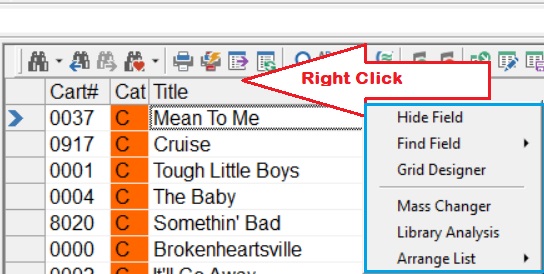
You have the powerful Mass Changer at your fingertips which allows you to mass change all sorts of things from adding/deleting/changing values to converting text to mixed case, etc. It is recommended that any time you choose to use the Mass Changer you make a backup of your database first in case you do not get the desired result. There is more info on the Mass changer in this blog article: https://musicmaster.com/?p=95
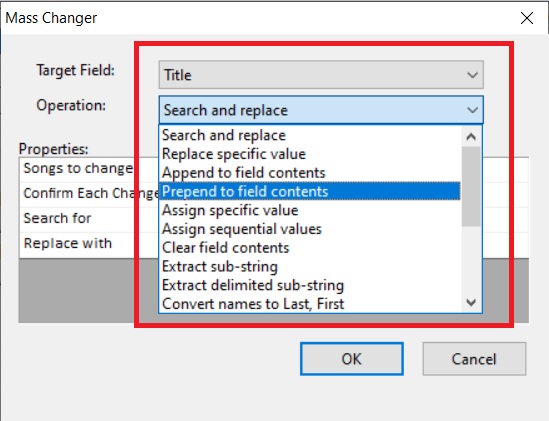
You can also choose the incredible Library Analysis feature here. Depending on what field you right clicked on, you will see an analysis of that field. In my example below I am looking at the Artist field and it is easy to see which artists have the most songs in the library.
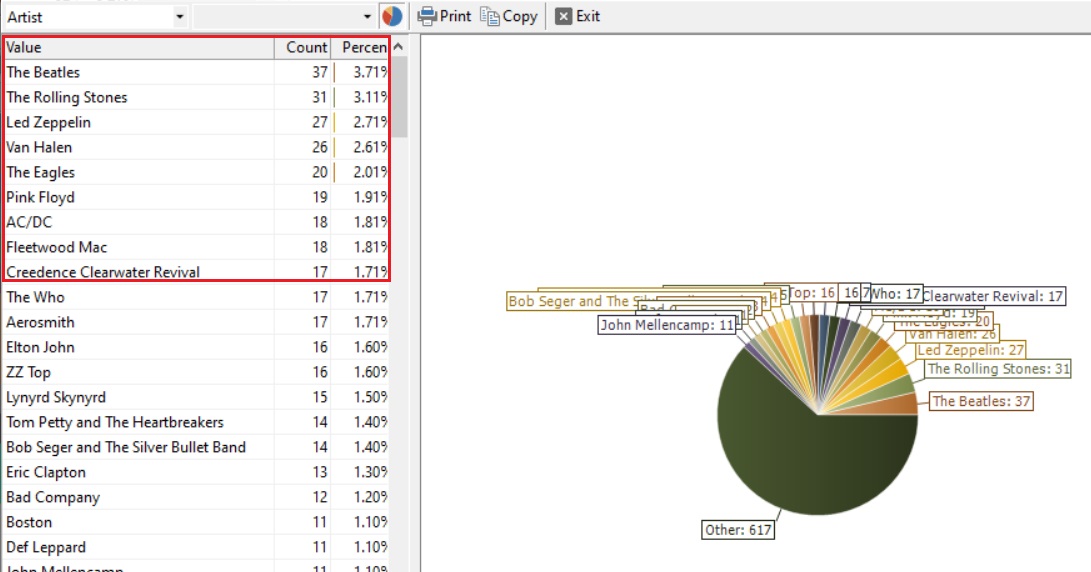
Again depending on which field header you are right clicking on, you will get different information. If you clicked on your Role/Gender field you would see the percentage of Male and Female artists (as long as that field is populated) or perhaps right clicking on your Sound Code, you could see the percentage of Rock, Urban or Acoustic songs you have or any other custom codes. My colleague Brian Wheeler wrote a great blog on this topic and you can find it here: https://musicmaster.com/?p=7268.
Clock Editor
If you are building or editing a clock, a right click gives you the same options as some of the buttons above do by allowing you to Insert, Clone or Delete an element.
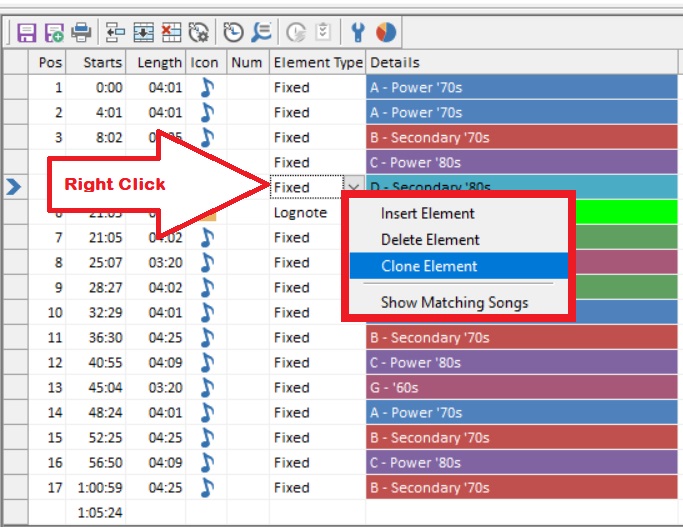
Rule Tree
This right click mania doesn’t stop there. Open your Rule Tree and you will find one of the most important right clicks in the program: Rule Tree Properties!
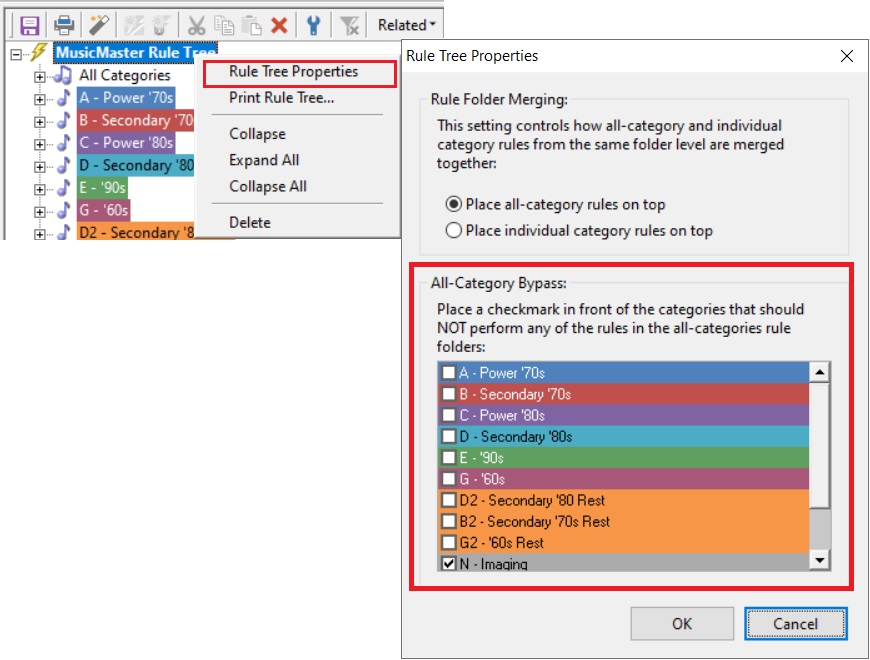
This special box allows you to bypass the rules in your All-Category folders so they won’t apply to certain categories. Why would you do this? Well you probably don’t want or need Artist Separation and Sound Code rules etc. to be performed on your non-music categories (Jingles, Imaging etc.) and if you schedule Christmas music during the season, you may want to bypass your Christmas categories because the regular rules might be too difficult to satisfy. You can then add just the rules you need in those specific category folders. Good stuff!!
Schedule Calendar
If you open your scheduling calendar and right click, you get some quick options that you may find useful.
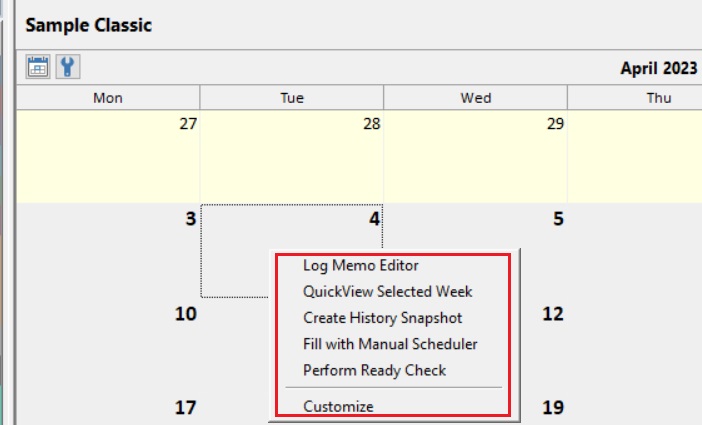
Schedule Editor
Jump into the Schedule Editor, and if you right click on the Hour Header, you get several options including the ability to insert, delete and unschedule an element. There are also two unique options including the ability to lock the hour to prevent any further editing of that hour, or you can pick to view the format clock for that hour (You can also do this by double clicking on the hour header as well).
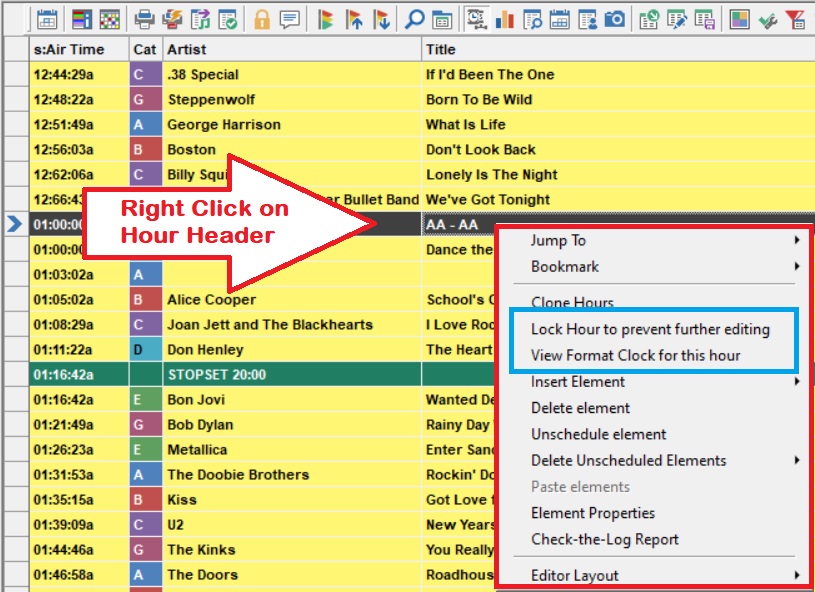
If you right click on an element (song, imaging, etc.) within the hour, you will see the same Insert, Delete and Unschedule options from the clock box, but here again are a couple options unique to this right click.
The first is the Scheduling Recap, which shows you the process MusicMaster went through based on your Rules, Optimum Goals, etc. to schedule each position in your log. The second is the “Audio” option which is awesome! Did you know you can listen to songs in the Schedule Editor or even Scope hours (listening to intros and segues)? This is a great way to listen to your log and see if it sounds as great as you think it does. In order for this to work you do need to set up and link your song cards to your audio, but don’t fret, here is a link to the step-by-step process to do just that: https://musicmaster.com/?p=3486.
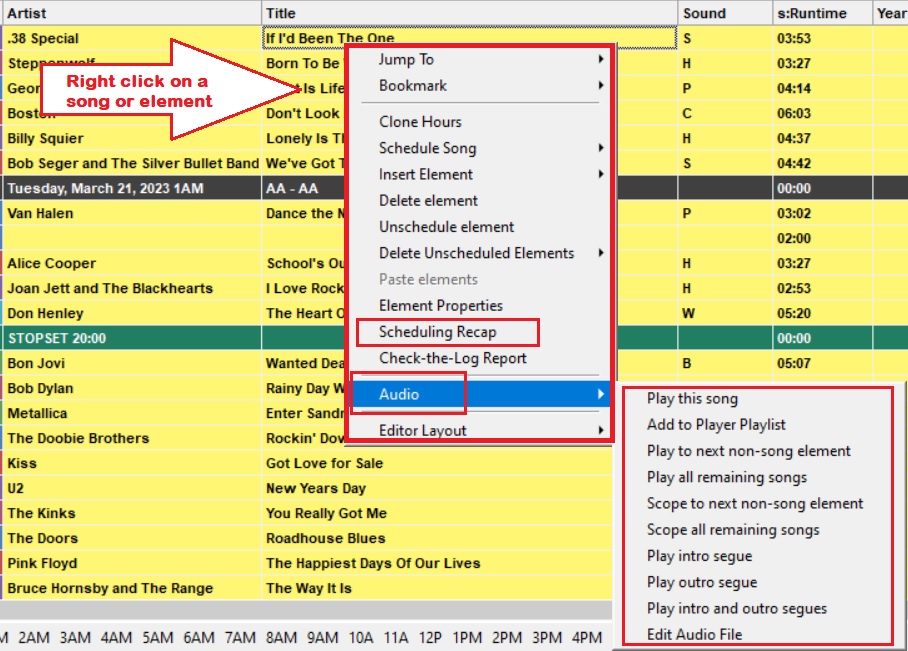
Turnover Analysi
Let’s move to Turnover Analysis. This ridiculously powerful area of MusicMaster is chock full of great information on how your categories work, but there is more to it than just what you see. Right click anywhere in the grid and you will see all of the fields available to put in your view. Checkmark a field and it is added.
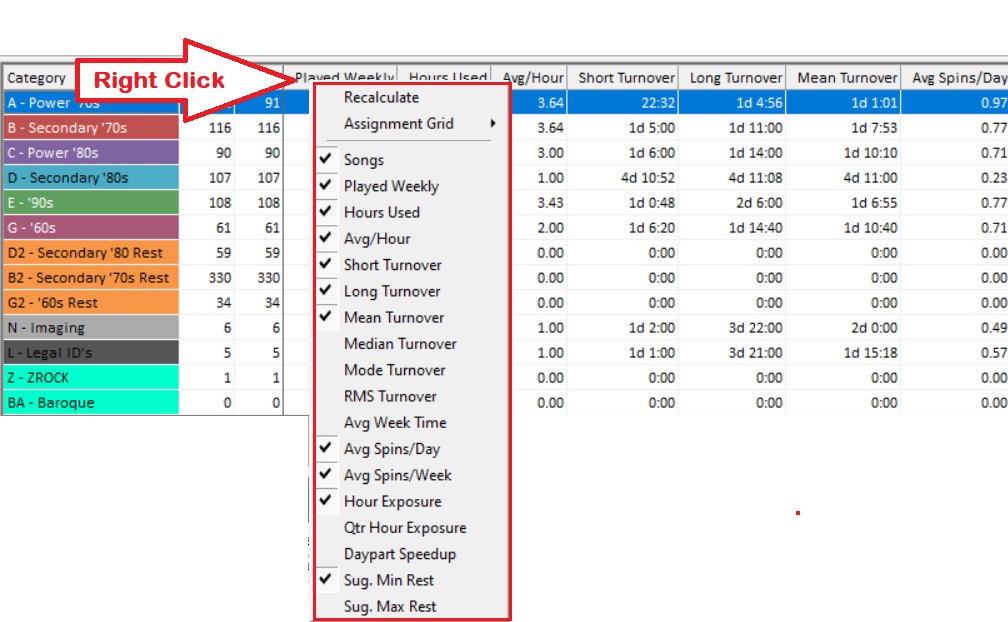
Want more information on the power of understanding Turnover Analysis? Check out this in-depth blog: https://musicmaster.com/?p=7832
These are some of the cool “Right Clicks” in MusicMaster that can help you manage your database, and control and create great Radio and TV. Just when you thought you knew it all, right?
Use the Info Bar next time you’re building clocks! posted on September 23rd, 2019
By Brian Wheeler
Building clocks is a task that most MusicMaster users visit infrequently. Many users will create a set of clocks and use them for long periods of time with little, if any, change. Other users may require more frequent changes but may not feel very efficient in this process. Are you maximizing the tools at your disposal?
There are many features in MusicMaster that make clock building and tweaking easier, but for now I’m going to focus on the Info Bar. The Info Bar is typically docked on the left side of your MusicMaster program if you have it visible at all. If you don’t have it visible, you can go to View, then select Info Bar to see all that the Info Bar has to offer.
The first thing you’ll likely notice is the list of your music and non-music categories from top to bottom. Not only can you click on these categories to get a quick view of each category’s contents, but you can also drag these categories into a clock that you are building. You can drag and drop an entire hour’s worth of music in a matter of seconds using the Info Bar.
You can also drag in lognotes. those commands for your playback system that you so carefully typed into your clocks are all retained under the clock tab at the bottom of the Info Bar. Click on the Clock tab, then select the ‘Lognotes’ header. There is your entire list of carefully created lognotes. You can drag and drop those into your clocks, too! No sense in having to type them all out again.
Also note in Version 7, the new Elements Tab in your InfoBar allows you to drag clock elements directly into place.

Using these tools, plus other great tools like the ‘clone’ feature in the clocks (use the toolbar or context menu option) can make the arduous task of creating or modifying clocks into a breeze.
If you’d like more tips and tricks to minimize your clock building/rebuilding time, give your MusicMaster Scheduling Consultant a call and we’ll be happy to show you all kinds of time-saving features.
Direct Field Entry While Editing Logs posted on July 29th, 2013
By Paul Ziino
Sometimes you just know what you want to play, but scrolling through the replacement song list seems like such a waste of time. At MusicMaster we value your time, so we have many ways to speed up this process. (more…)
Copying Music between Databases posted on February 25th, 2013
By Paul Ziino
If you are responsible for more than one MusicMaster Database, sometimes you might have to add the same song to multiple databases. Why go through the work of typing all that data over and over when you can just copy and paste between databases? (more…)
Clock Mass Changer posted on July 9th, 2012
By Aaron Taylor
Here’s a really handy feature in MusicMaster that can save you a TON of time when you need to change out a particular element in many different clocks. Instead of the chore of searching through your entire Format Clock Maintenance list and finding each instance of the item that needs to be adjusted, you can target that specific element in a database globally with the Clock Mass Changer. (more…)
Schedule Editor Wild Cards posted on April 26th, 2010
By Paul Ziino
When you are in the Schedule Editor, you can tell MusicMaster exactly what song you want to plot in any given position (more…)



